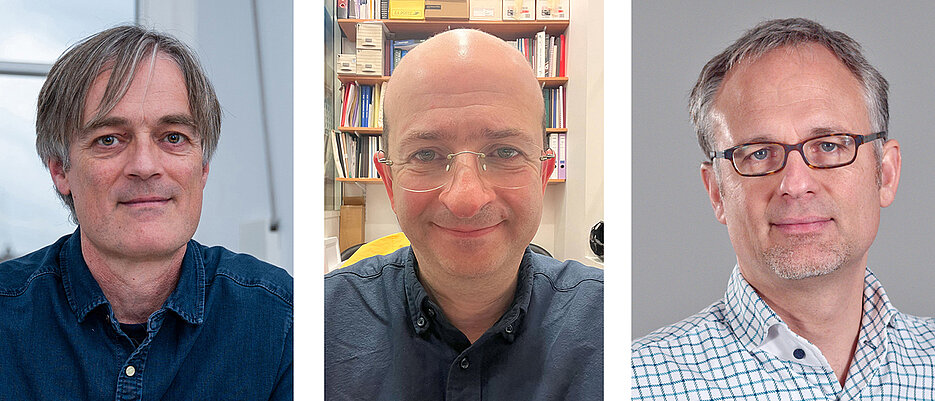Professors Ivo Boneca, Mark Brönstrup, and Christophe Zimmer have been awarded one of the most prestigious European research prizes, an ERC Synergy Grant worth eleven million euros.

No other research prize in Europe is as prestigious and as highly endowed as the Synergy Grants of the European Research Council (ERC): The award goes exclusively to teams of two to four researchers who come from different disciplines and pool their expertise to jointly achieve a particularly challenging, potentially ground-breaking research goal.
As announced by the ERC on 5 November 2024, a German-french team will receive a Synergy Grant worth nearly eleven million euros. The group is developing an AI-based solution to make the systematic search for new antibiotics significantly more efficient. It consists of Professors Ivo Boneca, Mark Brönstrup and Christophe Zimmer.
'By synergizing our expertise in microbiology, genetics, advanced microscopy, metabolomics, medicinal chemistry, computational biology and artificial intelligence, we propose to create a new pipeline at the forefront of the antibiotic discovery field that will be capable of informing simultaneously on the bioactivity and modes of action of new antibiotic candidates,' says Ivo Boneca.
The Researchers and Their Areas of Specialisation
Professor Ivo Boneca heads the Biology and Genetics of the Bacterial Cell Wall Unit at the Institut Pasteur (CNRS/Inserm). His lab is a leader in the field of microbial physiology and has made seminal contributions to the study of bacterial cell wall biology, developing antibiotics and elucidating their modes of action. The team routinely uses high-throughput imaging, high-resolution mass spectrometry and bacterial mutants to identify new antibiotic targets.
Professor Mark Brönstrup heads the department "Chemical Biology" at Helmholtz Centre for Infection Research (HZI) in Braunschweig. He holds a professorship at Leibniz University in Hannover that is also associated to the research area "Novel Antibiotics" in the German Center for Infection Research (DZIF). His lab is a leader in the field of natural product chemistry and novel antibiotics. The team has expertise in antibiotic lead generation and optimization, rational design of drug conjugates, medicinal chemistry, and mode of action studies using bioanalytical methods.
Professor Christophe Zimmer heads the Chair "Machine Biophotonics" in the Rudolf Virchow Centre at Julius-Maximilians-Universität (JMU) Würzburg. He is also affiliated with the Institut Pasteur in Paris, where he leads the "Imaging and Modelling" research unit. His lab is a leader in developing advanced microscopy and image analysis methods for biology. The team has long-standing expertise in developing optical and computational methods for single molecule localization microscopy (SMLM), high-throughput imaging, single molecule RNA-FISH, and adapting deep learning methods to address biological questions.
Scientific Background to the Project
More and more bacterial pathogens are becoming resistant to several antibiotics at the same time. This is one of the most pressing health problems of our time. In order to counteract such resistance, mankind urgently needs new antibiotics - especially those with completely different modes of action.
Large-scale screening is a mainstay method for the search for antibiotics. This allows compounds that impair bacterial growth to be identified relatively quickly from a large number of potentially active substances. 'However, the usual methods cannot predict by which mechanisms exactly the active substances will attack the bacteria,' explains Mark Brönstrup, adding that further, very time-consuming steps have been necessary to date in order to determine these mechanisms.
Focus on Seven Important Pathogens
The cooperation partners have therefore come up with the idea of using a rather different method for antibiotic drug discovery. Their method is intended to identify new antibiotic candidates and at the same time provide information on their bioactivity and modes of action.
Initially, the team wants to analyse a total of seven bacterial species, among them dangerous pathogens, using state-of-the-art methods to characterize their cellular and molecular profiles: Bacillus subtilis, Escherichia coli, Helicobacter pylori, Mycobacterium abscessus, Pseudomonas aeruginosa, Staphylococcus aureus and Yersinia pseudotuberculosis. This will result in a dataset of unprecedented size containing detailed information about these bacteria and their genetic mutants.
Deep learning analyses will then ensure that targets for antibiotics with novel modes of action are uncovered from this wealth of data. 'With this approach, we will analyse libraries of synthetic molecules and natural products, including complex mixtures, in the hope to determine whether they contain potential new antibiotic agents and to computationally predict their molecular mechanisms of action,' says Christophe Zimmer.
Project duration is six years
The trio's ERC project will start in 2025 and run for six years. Its official name is: 'Deep learning analysis of imaging and metabolomic data to accelerate antibiotic discovery against antimicrobial resistance' (AI4AMR).






